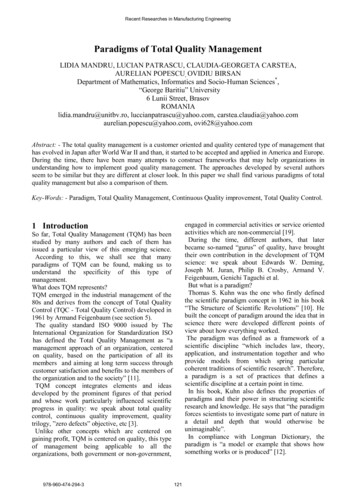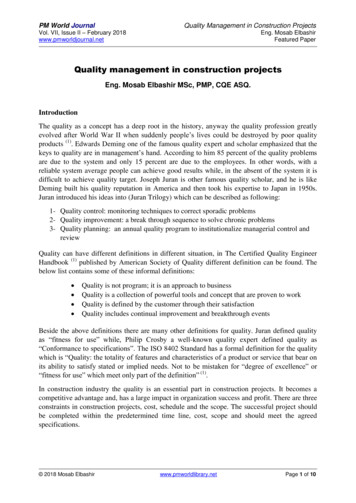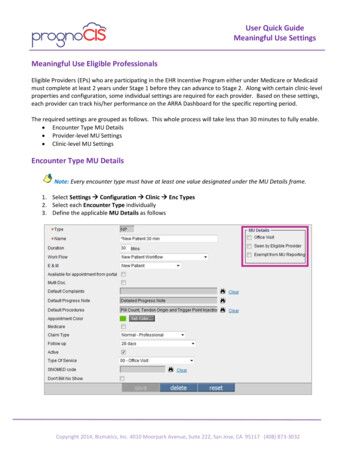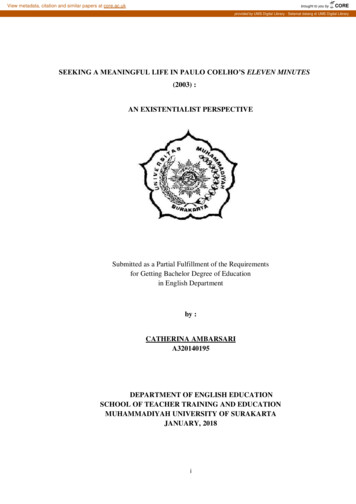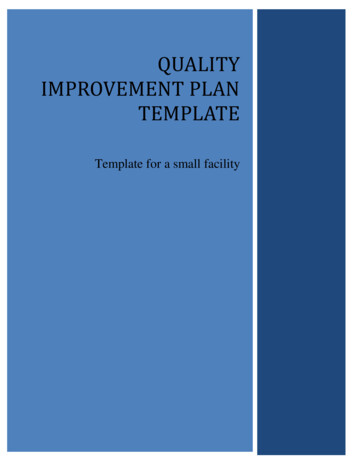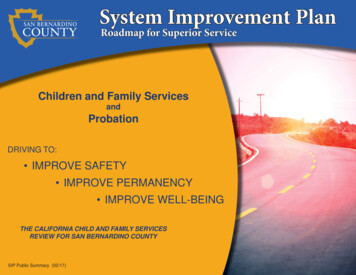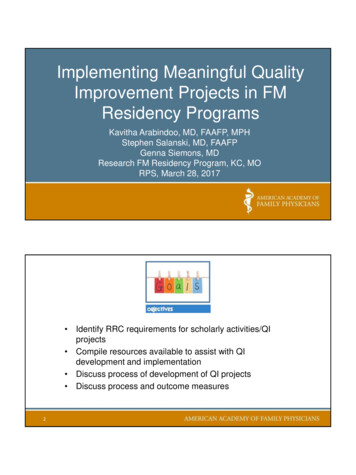
Transcription
Implementing Meaningful QualityImprovement Projects in FMResidency ProgramsKavitha Arabindoo, MD, FAAFP, MPHStephen Salanski, MD, FAAFPGenna Siemons, MDResearch FM Residency Program, KC, MORPS, March 28, 2017 Identify RRC requirements for scholarly activities/QIprojects Compile resources available to assist with QIdevelopment and implementation Discuss process of development of QI projects Discuss process and outcome measures2
3
‘Quality Improvement’ Quality improvement (QI) consists of systematic andcontinuous actions that lead to measurable improvementin health care services and the health status of targetedpatient groups (HRSA) IOM defines quality in health care as a direct correlationbetween the level of improved health services and thedesired health outcomes of individuals and populations6
Quality Improvement in Healthcare The combined and unceasing efforts ofeveryone—healthcare professionals, patients andtheir families, researchers, payers, planners andeducators—to make the changes that will lead to– better patient outcomes healthier patient– better system performance (care) less frustration atwork– better professional development better doctors andnurses Making changes integral part of this8
RRC requirements Residents’ requirements as of July 1, 2016– IV.B. Residents’ Scholarly Activities– IV.B.1. The curriculum must advance residents’ knowledge of thebasic principles of research, including how research isconducted, evaluated, explained to patients, and applied topatient care. (Core)– IV.B.2. Residents should participate in scholarly activity. (Core)– IV.B.2.a) Residents should complete two scholarly activities, atleast one of which should be a quality improvement project.– IV.B.3. The sponsoring institution and program should allocateadequate educational resources to facilitate resident involvementin scholarly activities.ABFM Requirements
ABFM’s criteria for meaningful QI Quality Improvement (QI) efforts must be developed usingbest available evidence criteria and national standards QI efforts must ensure meaningful physician participation QI efforts must incorporate self-evaluation, pre- and postintervention audits of physician performance using qualityindicators based on best available evidence QI efforts must incorporate the development andimplementation of an individualized plan for interventionwww.cdc.gov12
‘METRICs’
ABFM QI – ‘METRIC’ An innovative online practice/quality improvementprogram from the American Academy of FamilyPhysicians MeasuringEvaluating andTranslatingResearch (Evidence based guidelines)IntoCare (Patient)How does the METRIC Work? Step by step process that takes 1-few months depending onMetric chosenStage A: Learning from Current Practice– Complete Practice Assessment Questionnaire.– Enter data from patient charts (10 or 15 charts,depending on the module).– Assess personal performance and compare resultsnationally.
How does the METRIC Work? 18Stage B: Learning from the Application of PerformanceImprovement to Patient Care– Select from multiple interventions.– Use provided resources to develop Action Plan.– Implement Action Plan for a minimum of one month, usingtips, templates and resources from METRIC.
How does the METRIC Work? Stage C: Learning from the Evaluation of thePerformance Improvement Effort– Complete Practice Assessment Questionnaire (remeasure).– Enter data from patient charts (re-measure). Doesnot need to be the same patients as the baseline;patients need to have been seen sinceimplementation of the action plan.– Compare to baseline measurements and reflect onexperience3scYmK52 JXfYZC8a01FPlaTDZ49eA/g1GZM M SZ2xQLe2sHkzdVWh8tAJcReturnto R20
Challenges Identifying meaningful QIs for clinical practice Timeframe– Minimum 1 week!– Not enough for process or outcome measures! Data collection and analysis– Individual vs Cumulative Educating rest of the clinic staff/providers not directlyinvolved in the QI project23Challenges Stakeholder challenges– Nurses ‘one more thing to do’– Residents Time/rotational demands/lack of buy in– Faculty Need for ‘QI knowledgeable faculty’ Time! Time!! Time!!! Gathering meaningful data from EMR! Sustaining processes/outcomes long-term24
Solutions Develop QI projects pertinent to practice– ResPIP Work with IT to collect cumulative data forclinic Engage/educate stakeholders Identify TEAM/leader Identify process outcome measures25Solutions Cincinnati Children's Medical Center identified 4 key driversfor resident involvement in QI:– (1) knowledge of key concepts of improvement science (Instituteof Healthcare Improvement (IHI) Open School, the Association ofAmerican Medical Colleges Teaching for Quality report, the MichiganQuality System);– (2) resident-initiated quality QI projects and facilitation of “buyin”;– (3) protected time for learning and development of QI projects;and– (4) a sustainable system to keep track of resident-initiatedprojects.26
2728
29NEW!
31ResPIP Requirements for Programs Portfolio Manager– Attests to the participation of faculty and residents onQI projects undertaken in this track Formal Review Committee (3-5 members)– Approves and maintains information on all QI projects(New QI application template) over a 3 year period– Submits approval and completion of any new QIproject in this track– Submits periodic progress reports to ABFM
Goppert Trinity Family Care, KC, MOQI at RFMRP ABFM Requirement for residents Meets need for R2 scholarly projects’ completionrequirement (Residency Requirement) Maintenance of NCQA certification for PCMH
QI at RFM TEAMWORK! Use standardized QI tools consistently Choose process measures over outcomemeasures when possible Projects completed to date:– GO!D, ROR, Comprehensive Care, HPV vaccine(ongoing)35Keys to identifying Work Flow and ProcessImprovement EHR TEAMWORK!
GTFCC’s HPV Vaccine CommitteeGO! DIABETES TEAM37To improve, you must make changesBut Not all changes lead to improvement.Changes need to be efficient to be effective!
www.cdc.gov39
Fundamental Model for ImprovementWhat are we trying to accomplish?How will we know a change is an improvement?AimMeasuresWhat change can we make that will result in Improvement?PlanActFOCUSF – Find an opportunity to improve;Find the gap between knowledge &practiceO – Organize the effortC – find out how the Current processWorks by flowcharting; collect dataU – Understand/analyze data;Understand variation in dataS – Select the strategy to improveIdeasDoStudyPlan the improvement- Find the process to improve- Identify stakeholders- Identify the ‘Why’ as much as‘how’- Define the AIM statementAct to hold the gainsand continue to improve- Start the process overDo/ Implement theimprovementStudy the results- Collect data onprocess implementation- Collect data on desiredoutcomes
STEP 1: Develop An AimStatement Answers and clarifies “What are we trying toaccomplish?” Creates a shared language to communicate theproject to others S – specific M – measurable A – attainable R – relevant /realistic T timelyQI specific ‘Aim Statement’ Increase HPV vaccination rate of boys and girlsaged 11-18 years of age at GTFCC by 20percent during the study period of July 2016 toNovember 2016
STEP 2: Process Flow Maps Nuts and bolts of the PDSA cycle Observe the process Understand the current state Identify failure modes Determine your future stateWhy Map a Process?
Understanding the Current StateWork Flow and Process MappingPatient ContactPatientFront DeskMANurseProviderLabPharmacy
Fishbone and 5 Whys Analyze the problem and the potential causesthrough the use of cause and affect tools Uses an orderly, easy-to-read format Helps determine root causes Indicates possible causes of variation Increases process knowledge Indentifies areas for data collection
Building a Fishbone Start with a concise description of the “Effect” to whicheveryone agrees and place in the fish head Can be stated in the form of a question: Why do wehave low rates of HPV vaccination? Can be phrased as a positive (objective or AIM) ornegative (problem)Building a Fishbone Brainstorm the primary Causes influencing theEffect and list them for each category Secondary Causes may also be identified bycontinued brainstorming and asking “Why is thishappening”. Add sub-factors under each segmentand keep asking “Why” until you no longer obtainuseful information
Step 3: Defining the Measures Identify and track few (2-3) specific measures that areeasy to access and measure as part of the dailyroutine– Plot data over time Measurement should not slow things down– ‘Measurement is not the goal; improvement is the goal’ Seek usefulness, not perfection– Use sampling Qualitative (ROR) OR/AND quantitative data
‘Qualitative Data’ – HPV Survey Think back to 3 recent patient visits that involved an HPV vaccination visit---describe thedifficult questions that patients or parents asked you. Examples might include:Giving the vaccine will encourage sexual behaviorI’m uncomfortable talking about sexuality with the childI’m uncomfortable talking about the child’s sexuality with the parentI don’t think the vaccine is necessary for all childrenI’m concerned about side effectsI don’t feel that I have the knowledge to answer patients’ questions. (a)(b)(c)55Outcome vs Process Measures Outcome measures:– High-level clinical or financial outcomes thatconcern healthcare organizations.– Quality and cost targets that you are targeting forimprovement.– Often reported to government and commercialpayers– Examples mortality rates, readmission and surgical site infectionrates HPV vaccination rates in clinic
Outcome vs Process Measures Process measures– The evidence-based best practices thatrepresent a health system’s efforts tosystematize its improvement efforts– The ‘backbone’/’puzzle pieces’ for outcomemeasures– Example HPV vaccination during‘ill visit’ encounters– More feasible for short-term QI projects (3-6months)Outcome MeasureProcess MeasurePatients atNo. eligible forHPV vaccineHPV vaccineadministered35548 (13.5%)43450 (11.5%)11436 (31%)2865 (1.74%)349GTFCC aged 1118 years of ageTotal no. ofvaccine eligibleencountersTotal no. of‘Preventive’encountersTotal no. of‘Acute’ VisitsTotal no. of‘Nurses’’ visits58
In Summary Be innovative in selecting de novo Quality Improvementprojects that are pertinent to your residency programs. Choose process measures over outcome measureswhen implementing short-term QI projects. Identify and involve key stakeholders in theimplementation of the project.59Please Complete thesession evaluation.Thank you.60
References 61www.acgme.orgwww.theabfm.orgSR Smith, R Bakshi. (2015). Promoting Resident Involvement in Quality Improvement InitiativesThrough Faculty Involvement and Curriculum. J Grad Med Educ. 2015 Mar; 7(1): 119-120www.ihi.orgRosenbluth G, Tabas JA, Baron RB, et al. (2016). What's in It for Me? Maintenance of Certificationas an Incentive for Faculty Supervision of Resident Quality Improvement Projects. Acad Med.2016 Jan;91(1):56-9Carek PJ, Dickerson LM, Stanek M, et al. (2014). Education in quality improvement for practice inprimary care during residency training and subsequent activities in practice. J Grad Med Educ.2014 Mar;6(1):50-4www.cdc.gov
'Quality Improvement' Quality improvement (QI) consists of systematic and continuous actions that lead to measurable improvement in health care services and the health status of targeted


